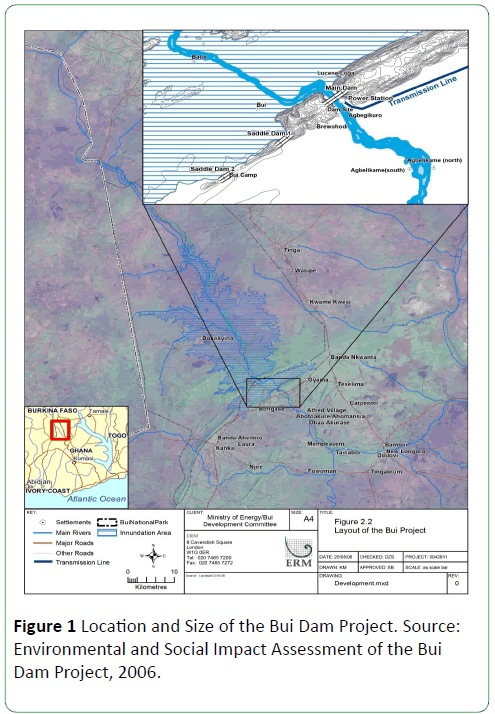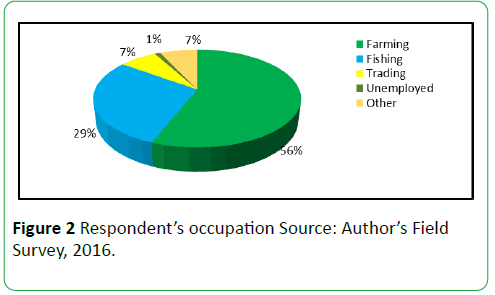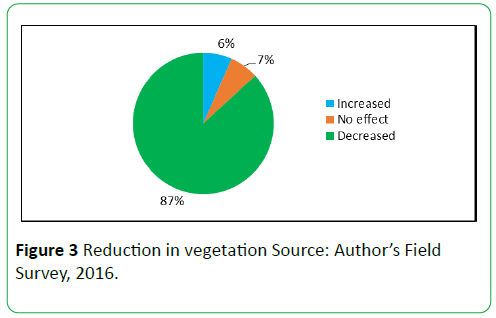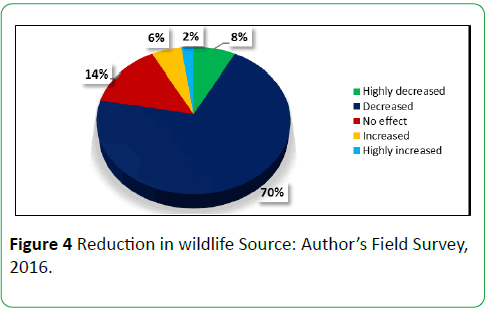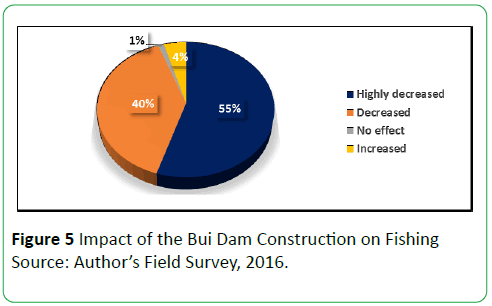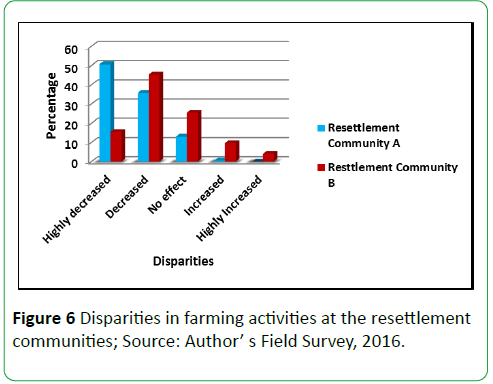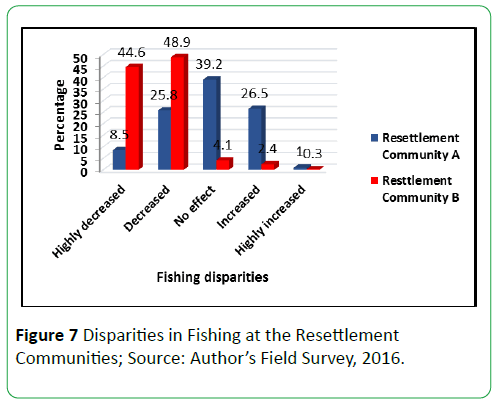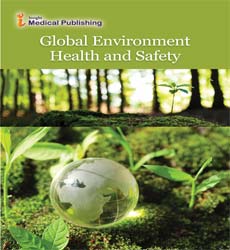Environmental and Socioeconomic Perturbations of a Dam Project on Catchment Communities, Ghana
Divine Odame Appiah*, Michael Sarfo, Bridgette Famieh, Henrietta Addai
Department of Geography and Rural Development, Kwame Nkrumah University of Science and Technology, Kumasi, Ghana
- *Corresponding Author:
- Divine Odame Appiah
Department of Geography and Rural
Development, Kwame Nkrumah University
of Science and Technology, Kumasi, Ghana
Tel: +233267979012
E-mail: dodameappiah@gmail.com
Received Date: September 18, 2017 Accepted Date: November 18, 2017 Published Date: November 28, 2017
Citation: Divine OA, Michael S, Bridgette F, Henrietta A. Environmental and Socioeconomic Perturbations of a Dam Project on Catchment Communities, Ghana. Glob Environ Health Saf. 2017, Vol. 1 No. 2: 13.
Abstract
Hydroelectric dams, both large and medium like the Bui dam in Ghana, have demonstrated their imposing nature, variously on the natural and social environment of the adjoining human settlements. The main objective of this paper is to identify and assess the environmental and socioeconomic effects of the construction and operations of the Bui dam on the catchment communities in the parts of Banda and Bole Districts of the Brong-Ahafo and Northern regions of Ghana. Triangulating quantitative and qualitative methods, the study employed a systematic and quota sampling techniques to administer partially pre-coded questionnaires to n=215 respondents, drawn from eight communities in the study area. Descriptive statistics such as percentages, mean scores and frequency distributions were used to analyse the data in statistical package for social sciences (SPSS) version 17. The results indicated that the main environmental aspects affected diversely by the construction and operation are vegetation and biodiversity, while the catchment communities’ farming and fishing livelihoods were also affected variously, due to the effect of the dam construction and operations on farm lands and water resources. The Bui Power Authority in conjunction with the resettled communities should ensure a sustainable livelihood and environmental resources management through dialogue and engagements.
Keywords
Environmental perturbation; Socioeconomic effects; Catchment communities; Bui dam; Ghana
Introduction
Humans have shaped the Earth’s landscape and manipulated natural processes to their own advantage since the beginning of our existence [1]. Dam construction is one of the major undertakings with the most deep-seated environmental modification against nature in the history and civilization of human beings [2]. The water manipulated and regulated by and stored in dams is crucial to meet the development needs of adequate water supply, intensive agriculture (i.e., irrigation and livestock), industrial use and energy generation [3].
Hydroelectric dams, therefore, have become the visible and significant projects for managing water and water-based resources for energy generation primarily and water supply as a consequence. The environmental consequences of dams are numerous and varied, and includes direct and indirect impacts on the biological, chemical and physical properties of rivers and riparian environments [4]. According to Canter [5], water resources projects such as dams represent behemoth engineering works that can cause significant impacts on socioeconomic components of the environment. Kyei-Dompreh [6] also adds that dams have many environmental effects, both anticipated and unanticipated and that access to previously undeveloped and distant areas due to the construction of dams can engender forest degradation. In the words of Osei- Nyarko [7], there are unacceptable and unnecessary environmental and social costs associated with the construction of dams.
Although, the construction of dams are seen as means of accelerating development, it has also been recorded, according to the World Commission on Dams [4], that most of these dams result in adverse social, environmental and ecological effects which many countries are still grappling with. Thus, no matter what the advantages of damming a river are, there are always some disadvantages that can derail the project. The recent review undertaken by the WCD concluded that, while large dams have immense contributions to the human development efforts, they have mostly failed to yield expected results. In many cases, their environmental and socio-economic consequences on the immediate communities have not only been unimaginable but also unnecessary and unacceptable [4].
In response to the energy crisis that embattled the country in 2007, the then government of Ghana in collaboration with Sino Hydro, a Chinese company which decided to revive the construction of 400 Megawatt Bui Dam which had been abandoned since the deposition of the First Republic. The dam has three main components. The first is the generation of hydroelectric power to supplement the electricity generation capacity of the two existing dams-Akosombo and Kpong in Ghana by 22%. The second is a reservoir of water for large scale commercial agriculture and the third is a Bui settlement. Currently, only the first component has been completed.
However, the prospects of the new dam are clouded by experiences with the earlier dams as they resulted in untold negative environmental and socioeconomic externalities unaccounted for, which continue to stare the country in the face to date [7]. Many commentators have therefore raised red flag concerning the negative environmental consequences the new dam is expected to unleash on the inhabitants as well as the fauna and flora of the catchment area.
The Environmental and Social Impact Assessment (ESIA) of the Bui Dam project identified some problems that are likely to accompany it. These include the inundation of landmass of up to 444 km2 at its Full Supply Level which would result in ripple effects including the involuntary resettlement of some 1,216 people, significant alterations in the livelihood strategies and upset of the sociocultural setup of the people, loss of biodiversity, soil erosion and land degradation; destruction of terrestrial and aquatic ecosystems; increase in water source illnesses; pressure on social amenities due to the influx of people into the area [8]. Based on the ESIA report, mitigation measures were put in place to help contain and ameliorate these effects. However, past experience shows that the success of mitigation measures is extremely variable and far from assured [9]. Apparently a number of environmental and socioeconomic issues concomitant to the dam construction have surfaced in the area after the construction despite the mitigation measures put in place to contain the impact of the project. It is in the light of this development that this study seeks to examine the effects of the Bui Dam Project on the catchment communities within environmental and socioeconomic contexts.
The Bui Dam Project, like many of its kind, was to guarantee Ghana’s electricity supply and to provide opportunities to develop the neglected northern parts of the country [7]. Having learn from the unfortunate experiences of the Akosombo and Kpong [10] wad an Environmental and Social Impact Assessment (ESIA) which carried out on the Bui Dam Project. This brought to the fore, a whole gamut of environmental, social and economic consequences concomitant to the dam and its catchment communities. An Environmental and Social Management Plan (ESMP) and a Resettlement Planning Framework (RPF) were, therefore, the companion documents prepared to provide mitigation measures meant to address all the issues that were captured in the ESIA.
However, as Osei-Nyarko [7] puts it, there is always a lapse between planning and implementation leading to problems of achieving desired objectives. The actual implementation of the restoration measures through community resettlement programmes, as an adaptation measure with respect to the construction and operation of the dam, has been everything but [11]. The physical environment has been unduly affected as a large portion of the Bui Forest Reserve has been degraded and aquatic and terrestrial ecosystems interfered with [12] with some deleterious consequences on livelihoods of the catchment communities.
According to Miine [13] the resettlement programme undertaken, has come with social and environmental challenges, due to loss of prime sources of livelihood. These include the loss of fertile lands and fishing grounds and the fact that farm lands are owned by the host community, access to extra land has been very daunting. This situation has been very difficult to be adapted to by the resettled communities. Consequently the income of farmers and the fisher folks within the catchment area has been adversely been affected. This has therefore put intense pressure on households to look for other sources of livelihood such as charcoal production, illegal mining (galamsey) and poaching at the expense of the forest conservation.
The cultural setup including chieftaincy and power relations between the host and settler communities and the Bui Power Authority are fragile, creating fertile grounds for potential conflicts [12]. The apparent weaknesses in most of the mitigation measures are predicted to further exacerbate the plight of the inhabitants and the state of the natural environment. Previous researchers have concentrated on either environmental or the economic ramification of the construction and operation of large dams. However, little research attention seemed to have been placed on the potential social and environments upheavals that small dams could pose on the natural and social environments.
This is line with United Nation Environment Programme (UNEP, 2010) report which states that, the livelihoods of inhabitants in developing countries are directly at the mercy of the wellbeing of the environment. On the bases of these concerns two key questions are raised and addressed in the paper what are the main environmental challenges of the construction and operations of the Bui dam? And what are the socioeconomic consequences of these challenges on the livelihoods of catchment communities? Therefore the main objective of this paper is to identify and assesses the environmental and socioeconomic effects of the construction and operations of the Bui dam on the catchment communities in Ghana.
Methods
The study area
The Bui Dam Project is located in the Bui gorge on the Black Volta along the borders of the Brong-Ahafo and Northern regions of Ghana at the southern end of the Bui National Park. The specific towns affected by the dam construction are Brewohodi, Dam Site, Agbegikuro, Lucene, Bui Village, Bator/ Akanyakrom and Dokokyina. These communities upon resettlement have been categorized into two as the Resettlement BUICOM A (BUICOM A) comprises Agbegikuro, Brewohodi, Dam Site and Lucene other one is re-settlement BUICOM B (BUICOM B) also consists of Bator/ Akanyakrom, Dokokyina and Bui Village.
BUICOM A is hosted by Gyama in the Bole District of the Northern Region, whereas resettlement BUICOM B is located near Bongase in the Banda District of the Brong-Ahafo Region ( Figure 1). These two resettlement communities are now managed by the Bui Power Authority (BPA). Resettlement BUICOM A has a total population of 403, whereas BUICOM B has a total population of 1,621 as of 2015 (GSS, 2015). According to the environmental impact assessment (EIA) report of the Bui Dam project, majority of the inhabitants are engaged in farming and fishing with a few engaged in hunting, livestock rearing and trading.
The study area lies within the Moist Semi-Deciduous Forest and the Guinea Savannah woodland vegetation zones. The Bui National Park as well as the Bui Forest Reserve lies within the catchment areas of the dam. Wildlife like the monkeys, deer, hippopotamus and antelopes abound in the Bui National Park. The combination of the vegetation zones; Guinea Savannah and the Forest permit the cultivation of a variety of cropscereals, tubers and vegetables; and animal rearing. Trees in the forest reserve help protect the Black Volta on which the Bui Dam is built and other water bodies from excessive evapotranspiration. The prevailing climatic conditions in the study area are the same as that of the Banda and Bole districts. The temperature in the study area is generally high with an average of about 24.5ᵒC throughout the year (GSS, 2015). The mean annual rainfall is between 1,140 and 1270 mm, thus indicating a double maxima rainfall regime. Relative humidity of about 75% is high in the wet months and low in the dry months.
Research and sampling design
This study used a triangulation of the quantitative and qualitative research design, as the appropriate approach for the study. This is informed by the fact that this study seeks to and among others, explore and assess holistically the environmental and socioeconomic effects of the Bui dam Projects on the catchment communities. In order to obtain the accurate data, the two methodological approached leverages on the respective strengths of each other to even-out any embedded weaknesses of each method.
The sample frame included the total number of households within the dam catchment area. The study defined a household to be any group of people, commonly associated by the use of a common eating and sleeping arrangements. The sampling frame consisted of all the 215 households in the study area. This sampling frame was obtained from a population projection from the 2007 census of the area during the EIA. The total population in the study area according to 2015 projection at 2.3% was 2,024 people.
The probability and non-probability sampling techniques were employed to select respondent for the study. A multiphase sampling strategy included a mixture of simple random, systematic and stratified sampling procedures were used. Probability sample strategy was used in selecting the households for the administration of questionnaire. The researcher initially developed a numbered list of all households in each resettled community. This was easy to do because the resettlement housing structures were constructed based on households. The list for each community was then arranged alphabetically.
Through systematic sampling procedure, the study selected the sample units. This was done by determining the sample interval needed for the selection of the nth household from the list. The sample interval was determined by dividing the population or sampling frame by the desired sample size needed in each community. After the determination of the sample interval, the households were numbered and written on pieces of paper. The pieces of paper with the numbers written on them were put in a bowl and well shuffled. One piece of paper was drawn from the bowl at random, and this represented the starting point for the first sampled household for the selection on the 2nd household.
The study made use of questionnaires, interviews and observation to collect data from primary sources. Survey questionnaires were targeted at household heads. The questionnaires were interviewer administered to the respondents in the field. The interviewer administered questionnaires enabled the researcher to allay respondents’ fears, distress and anxiety over issues raised in the questionnaires. However, the main limitation of selfadministered questionnaires was that in the presence of the researcher some respondents could have given responses they deemed socially or culturally acceptable. Therefore respondents might have given responses that do not truly represent their situation. Hoggart [14] noted that respondents may express different views according to their reaction to the interviewer.
The questionnaire content captured data on the environmental and socio socio-economic impacts of Bui Dam construction in the study area as well as the sociodemographic aspects of the population. The survey questionnaires had both closed-end and open-ended questions. The limitation of the use of Likert’s scale in some of the questions introduced subjectivity and some biases into the results. Structured interviews, using interview guide with government officials and other key informants were also conducted. These included the officials of the Bui Power Authority, Bui National Park, Assembly members, Environmental Protection Authority (EPA) as well as chiefs and opinion leaders in the communities. In addition direct observation was also used in gathering primary data.
The data were processed by cleaning, coding and analysed using descriptive statistics such as calculated frequencies, percentages, means, charts and graphs embedded in the Statistical Package for Social Sciences (SPSS) version 17. To extract he qualitative data, thematic content analysis was done to classify the responses and used in the quotations as buttresses to the quantitative results analysed.
Results
Environmental and socioeconomic effects
According to Beck et al. [15] the effects of the construction of dams on the biological, geophysical and chemical processes on rivers and surrounding communities are enormous. The construction of dams invariably leads to the inundation of land and the destruction of both fauna and flora on the land. This section presents the analysed responses from the questionnaires administered to respondents, during the study. There was also in-depth interview with some of the respondents.
Occupation of respondents
The results indicate that out of the 91 respondents interviewed, 51 representing 56% are engaged in farming, 27 representing 29% are engaged in fishing, 6 respondents representing 7% are into trading while 1 and 6 representing 1% and 7% are unemployed and other respectively. The cumulative percentage of farming and fishing is 85% indicating the importance of natural-resource dependent livelihoods to the study communities. Any significant changes in the physical environment therefore have effects either positively or negatively on the livelihoods of the people who depend on it. It can result in an untold hardship in the study area if the effect is negative or relatively better living if the effect is positive. Figure 2 illustrates the livelihood activities of the respondents.
Construction and operations on vegetation cover
The effects of dams on the biophysical and chemical processes of rivers and surrounding environment have been extensively documented [15]. The environmental consequences of dams are numerous and varied, and includes direct and indirect impacts to the biological, chemical and physical properties of rivers and riparian environments [4]. Kyei-Dompreh [6] also adds that dams have many environmental effects, both anticipated and unanticipated.
Construction and operations on vegetation cover
The effects of dams on the biophysical and chemical processes of rivers and surrounding environment have been extensively documented [15]. The environmental consequences of dams are numerous and varied, and includes direct and indirect impacts to the biological, chemical and physical properties of rivers and riparian environments [4]. Kyei-Dompreh [6] also adds that dams have many environmental effects, both anticipated and unanticipated.
A major environmental effect of the dam has been the destruction of a large portion of the vegetation that hitherto covered the Bui gorge. From the analysis majority of the respondents indicated, there has been a decrease in the vegetation cover in the area and a lower percentage indicated that the vegetation cover has highly decreased as compared to before the construction of the dam. Only a few respondents indicated that the dam has had no effect on the vegetation cover whilst yet a lower proportion indicated an increase in the vegetation cover.
The semi-deciduous forest provided habitat for most of the wildlife in the Bui National Park. The forest also served as source of livelihood for most of the people who lived on its fringes. They picked forest products such as snails, mushrooms as well as collected firewood from the forest for sale and also for domestic use. The survey revealed that a large portion of the forest was cleared to make way for the construction of the dam and the resettlement communities leaving the shrubs submerging in water during the impoundment. Currently, there is on-going construction of buildings for officials of the Bui Power Authority (BPA) at Gyama which has also led to a further destruction of vegetation.
Another issue that further threatens the vegetation cover in the study is the high dependence of the inhabitants on wood fuel (firewood and charcoal). The inability of the inhabitants to diversify their domestic energy sources to include gas and other sustainable energy has put a lot of pressure on the vegetation. The challenge is that if the trend continues the vegetative cover around the dam will be depleted. The loss of vegetation discovered has occasioned hot weather conditions in the area making live uncomfortable for the people. According to World Commission on Dams, WCD [4] large dams have impact on microclimate due to huge loss of plant cover. Vegetation cover serves as source moisture, habitat for wildlife and also provides shade for people. Figure 3 shows the percentage decrease in vegetation at the Bui dam catchment.
Construction and operations on biodiversity
It was stated in the Environmental Impact Statement (EIS) of the Environmental Impact Assessment (EIA) study that the construction of the Bui dam will result in the inundation of some 440 km2 of the Bui gorge. The Bui gorge contains the Bui National Park (BNP) and the habitat for much wildlife such as monkeys, chimpanzees, etc. Large numbers of hippopotamus live in the Volta River along the gallery of the Bui forest. The communities nearby, before the construction of the dam had the opportunity of frequently seeing these animals. According to some of the respondents some wildlife like antelopes, deer, etc. frequently appeared in the neighbourhoods. The presence of wildlife also reflected the frequent visits of tourists to the area and sometimes employed some of the community members as escorts with approval from the management of the BNP.
From the analysis, majority of the respondents indicated that the abundant wildlife has reduced after the construction of the dam while a small percentage of the respondents indicated the biodiversity has highly decreased. This assertion was made on basis of their inability to frequently see any wildlife in the area as before the presence of the dam and the drastic reduction in tourist numbers. They mentioned that people do come to the area only to see the dam, but not the wild animals as it previously was the case. Also, 14.3% indicated that the dam has not had any effect on the biodiversity, with the remaining small proportion indicating an increase in wildlife abundance. According to most of the people interviewed, most of the animals drowned whilst some fled to other areas during the inundation.
An official from the management of the BNP stated this in an interview, “In fact there are very few animals left in this forest; most of them drowned in the reservoir because we couldn’t rescue them fast enough while most fled due to the frequent noise produced during the construction. About 80% of the people who come here do so because of the dam and not to see the wildlife as before”. This is illustrated in Figure 4.
Economic effects of the Bui dam
Interactions with the resettled communities revealed that their sources of livelihood have been affected by the construction of the dam. Hence this section looks at the impact of the resettlement on the farm production and fishing since farming and fishing are their main sources of livelihood.
Farm sizes: One factor that has the potential to significantly affect farm produce is farm sizes. Bogale, Shimelis and Aidoo et al. [16,17] make an assertion in their work that food production can be increased extensively through expansion of areas under cultivation. The respondents revealed in an interview that in their previous location, shifting cultivation and farm rotation were common practices due to unrestricted access to farm lands. However, in their current location, Bui Power Authority (BPA) has given them land to farm but the land sizes were too small for them. They therefore have no option than to cultivate on a piece of land continuously without fallowing leading to poor yield. Some of the respondents recounted how the land given to them by the BPA has been taken over by water. One of the respondents in an interview remarked, “they promised to give us additional land to supplement what we have been given already and also for posterity, but this promised is yet to materialize. I foresee, in no distant future, we may leave our homes due to hardship”.
Farm production: The study revealed that the resettlement has negatively affected farm production. After resettlement farm output has reduced as a result of poor soil fertility, their inability to practice shifting cultivation native to them due to small and fixed farm lands allocated to them. They indicated that farm produce has reduced drastically since their relocation and has since affected their livelihood thereby affecting their overall economic standing. With majority of over 95% of the respondents affirming that farm production has decreased is a clear indication of deterioration in farmdependent livelihoods. They opined that in their previous location, production was bountiful. They sold some as well as stored some for their subsistence needs. Money from the sold produce was used to cater for medical, educational, and other needs of their dependents as well as their own needs that required money.
Margin of farm produce decrease: The study further probed to analyse the margin of decrease in the farm produce from which the majority (38%) indicated that the margin of decrease is between 61-80% and about 21% of the respondents also indicated that the margin of decrease is between 41-60%. One of the anonymous respondents explained further in an interview, “I used to convey more than two Kia trucks full of yam to Techiman market after deducting what my household would consume in the year. But now I can’t even get one motor Kia truck from my farm after harvest all because of this resettlement thing. I wish I could leave, but I have nowhere else to go to”.
Another respondent also indicated that, “I haven’t sold a single tuber of yam since we came. We I get from the farm can’t even feed my household. Sometimes I have to buy food to supplement what I get from the farm due to low output; in our previous location I was a prominent yam farmer”.
These statements only point to one fact; that the construction of the dam and the resultant resettlement has negatively and significantly affected the livelihoods of the catchment communities.
Fishing: Fishing is the second major livelihood activity in the study area after farming. Approximately 30% of the respondents indicated that they engaged in fishing as their main occupation. As most of the people inhabited the banks of the Volta River, they adopted fishing as a livelihood activity. Majority of the respondents indicated that fishing has been negatively affected by the dam, with about 55% indicating that the decline is very high. Only 1.1% said the construction of the dam has not affected fishing in the Volta River. However 4.4% indicated that fishing has improved after the construction of the dam. The respondents who believed fishing activities have gone down, however were quick to add that it was booming at a particular part of the river which was far from them. However till now they neither have boats nor canoes to cross the river and fishing is currently no longer a lucrative activity as compared to before the construction of the dam.
Another issue which came up in the survey and further confirmed a study by Osei-Nyarko [7] was that the men who engaged in fishing as their core livelihood activity indicated that their current location was very far from the river limiting their frequency to the river for fishing. Figure 5 illustrates the effects of the Bui dam construction on fishing at the catchment area.
Figure 5: Impact of the Bui Dam Construction on Fishing Source: Author’s Field Survey, 2016.
Disparities in the effects of the dam on the livelihood activities: According to Mudzengi [18] the positive and negative socioeconomic effects of the construction of distributed with regard to the two resettlement communities. There were disparities in the effects of Bui Dam on farming and fishing in relation to the two resettlement communities and these disparities in the effects of the dam are directly related to the location of the resettlement community. Dams are very selective both spatially and socially. Analysis of the data gathered during field survey revealed that the effects of the Bui Dam on livelihood activities were not equally.
Disparities in farming activities: Respondents in Resettlement BUICOM A indicated that they were more disadvantaged in terms of farming given the fact that they were joined to a host community Gyama, who did not give them access to their farm lands, and also the land given to them by the Bui Power Authority to farm was inadequate and a larger portion has been taken over by water. About 50.7% respondents from Resettlement BUICOM A indicated a high decrease in farming. This has led to a shift in livelihood activities from farming to fishing in Resettlement BUICOM A. Analysis of the responses revealed a quite different situation in Resettlement BUICOM B, as they are not hosted by any BUICOM A as such restriction on accessibility to farm lands was not much of a problem. About 25.5% respondents from Resettlement BUICOM B indicated the dam has no effect on farming with 9.6% and 4.2% indicating an increase and high increase in farming respectively. The results are displayed in Figure 6.
Disparities in fishing activities: Resettlement BUICOM B on the other hand is more disadvantaged with regard to fishing due to the fact that they are father away from the fishing ground compared to BUICOM A. From which the decrease is high. This development has led to a shift in livelihood activities from fishing to farming in Resettlement BUICOM B. They are however relatively less disadvantaged with respect to fishing due to the fact that their current location is closer to the part of the river where fishers are allowed to fish. Figure 7 indicates the disparities in farming at the two resettlement communities. Majority of respondents from BUICOM B indicated a decrease in fishing and 44.6% revealed.
Figure 7: Disparities in Fishing at the Resettlement Communities; Source: Author’s Field Survey, 2016.
Discussion
The study was conducted to identify the environmental and socioeconomic disturbances of the Bui dam on the catchment communities and the analysis of the results clearly indicated the negative impacts the Bui dam has had on the catchment areas. The effects of the construction and operations of the Bui dam on the biophysical and socioeconomic conditions of the catchment area are in tandem with the documented consequences as reported by Beck et al. [15].
The large clearing of forest for the dam has led to a considerable reduction in the vegetation cover around the catchment areas. Also impoundments invariably lead to the submerging of productive land. These vegetation losses have had significant adverse effects on biodiversity and microclimate [4]. Canter [5] also noted that the shift from riverine to Lake Environment as the impoundment has caused by the Bui dam can result in the reduction of species diversity and can also result in the endangering and extinction of rare riparian plant and animal species [18].
The reduction in vegetation has led to a resultant loss in wildlife at the catchment area as these animals have lost their habitats and some have drowned. Mudzengi [18] notes that impoundments lead to decreased woodland thereby adversely affecting wildlife communities. Degradation of habitats and vegetation fragmentation was also identified as cause of environmental transformation and depletion of local wildlife populations. This accordingly, is a key global biodiversity threatening process [19]. Forested riparian zones perform a wide range of ecosystem functions such as stabilizing stream banks, serving as wildlife habitats and ecological corridors [20]. According to Girmay [10] deleterious and unforeseen consequence of deforestation as a result of the conversion of forest to agricultural land and human settlement due to the dam construction and resettlement, has been a recipe for the loss of biodiversity.
Terrestrial biodiversity are currently undergoing population declines due to a range of land management changes such as land clearing and there have been reported cases of low abundance of mammals in areas with thinning vegetation [19]. It also conforms to Mudzengi [18] that impoundments lead to decreased woodland thereby adversely affecting wildlife communities. Generally the dam has been constructed in hitherto uncultivated and unsettled areas opening the areas for human interaction leading the degradation natural habitat in such areas. For instance since the dam is built in a forested area, quite frequently farmers and communities affected are forced to clear lands upstream of the reservoir for the cultivation of crops and building of settlements. While the benefits of a dam project can be worthwhile, any disruption of natural processes brings economic, social and environmental impacts.
Socioeconomically farming activities Bui dam catchment have also decreased partly due to the small lands available to the re-settlers at the resettlement communities. This is because as people become displaced by dam construction they may be moved to land shared by others, as a form of land based livelihood restoration [18]. Wolde-selassie [21] defined resettlement as the movement of communities from one environment to the other and alterations of the physical and social environment in which re-settlers find themselves in and adapt to. On the other hand, in an involuntary or legally enforced resettlement as in the case of the Bui dam the resettlers do not have the choice than to move, otherwise resettlers are likely to be more disadvantaged than advantaged, in the long run. Also part of the lands at the catchment area has been taken over by water and this is supported by Mudzengi [18] that dams raise the natural level of rivers leading to the flooding of used and unused lands, as occasionally experienced by some of the communities within the Bui catchment.
Another livelihood activity that has been affected adversely in the Bui catchment areas is fishing. This is because as dams act as significant barriers by blocking the downstream flow of sediment and nutrients it also prevents the migration of fish and other aquatic organisms [22,23]. The respondents depended substantially on their natural environment for their livelihood, as such changes in their riverine environment due to the Bui dam affected a major livelihood activity-fishing which is heavily depended on for food protein and income.
Traditional farmers strive to work efficiently and effectively with the available natural capital and resources around them [ 24]. These measures were some seeming livelihood adaptation measures, used by the catchment communities for survival. This was evident during the study, where respondents at the resettlement BUICOM B have switched their livelihood activity from fishing to farming though on relatively smallholding scales.
Conclusion
The paper has ruminated the ramifications of the construction of the Bui dam. It has looked at the issues from a bifocal perspectives; the environmental dimensions of the effects and the socioeconomic aspects. The Bui dam like any other medium dam projects has been without any adverse impacts irrespective of the lofty intended motives of construction for the generation of energy and water supply for irrigation agriculture as well as a promotion of ecotourism. Due to the peculiar economic conditions of the catchment communities, the impact of the construction has, from the perspectives of the catchment inhabitants been adverse. Continuous engagement has been the mode of identifying and redressing of the key environmental and socioeconomic issues by the Bui power authority and the catchment communities this approach the paper endorses to ensure intergenerational equity of the resource use and management in the dam catchment.
Acknowledgement
We are also grateful to the positive contributions of Miss Bernice Adu-Boahen for her proofreading of this manuscript. We also thank the department of Geography and RURAL Development for the availability of office space and time. Finally we acknowledge the anonymous reviewers for their critique to improve the quality of the paper.
References
- Bird E (2012) The Socioeconomic Impact of Hydroelectric Dams on Developing Communities: A Case Study of the Chalillo Dam and the Communities of the Macal River Valley, Cayo District, Belize, Central America, Environmental Studies Electronic Thesis Collection Paper 14: 115.
- Ngabea SA, Liberty JT, Bassey GI (2013) Environmental Impacts of Kashimbilla Multipurpose Buffer Dam and Associated Structures, Taraba State, Nigeria. Int J Innov Tech Exp Eng 3: 74-79.
- Ledec G, Quintero JD (2003) Good Dams and Bad Dams: Environmental Criteria for Site Selection of Hydroelectric Project. Latin America and Caribbean Region Sustainable Development Working Paper 16, The World Bank.
- World Commission on Dams (2000) Dams and development: A New Framework for Decision-making. London: Earthscan. World Commission on Dams.
- Canter L (1985) Environmental Impact of Water Resources. Chelsea MI: Lewis Publishers.
- Kyei-Dompreh F (2012) Management of VRA Resettlemnt Towns: Case Study of West Kpong Resettlement Town. Institute of Distance Learning Kwame Nkrumah University Science of Technology Kumasi Ghana.
- Osei-Nyarko P (2009) Appraisal of Planning Phase of the Resettlement Component of the Bui Dam Project. Lessons from Akosombo Dam Resettlement. School of graduate studies, Kwame Nkrumah University of Science and Technology.
- Environmental Resources Management (2007) Resettlement Planning Framework (RPF) Available at www.erm.com for the Bui Hydropower Project Environment.
- Berkamp G, McCartney M, Dugan P, McNeely J, Acreman M (2000) Dams Ecosystem Functions and Environmental Restoration Thematic Review II. Available at www.dams.org. Prepared as an input to the World Commission on Dams. Cape Town.
- Girmay Y (2006) Assessing the Environmental Impacts of a Hydropower Project: The case of Akosombo/Kpong Dams in Ghana. Royal Institute of Technology, Stockholm, Sweden.
- Zwikael O (2009) Critical planning processes in construction projects. Construction Innovation 9: 372-387.
- Tornyie F, Kwapong PK (2015) Nesting ecology of stingless bees and potential threats to their survival within selected landscapes in the northern Volta region of Ghana. African Journal of Ecology 53: 398-405.
- Miine LK (2014) Sustainability of Bui Settlement Scheme in Ghana. School of graduate studies, Kwame Nkrumah University of Science and Technology.
- Hoggart K, Lees L, Davies A (2002) Researching human geography. Arnold, London.
- Beck MW, Claassen AH, Hundt PJ (2012) Environmental and livelihood impacts of dams: common lessons across development gradients that challenge sustainability. Int J River Basin Man 10: 73-92.
- Bogale A, Shimelis A (2009) household level determinants of food insecurity in rural areas of Dire Dawa, Eastern Ethiopia 9: 14-26.
- Aidoo R, Mensah JO, Tuffour T (2013) Determinants of household food security in the Sekyere-Afram plains district of Ghana. Euro Sci J, pp: 514-517.
- Mudzengi BK (2012) An Assessment of the Socio-Economic Impacts of the Construction of Siya Dam in the Mazungunye area: Bikita District of Zimbabwe. J Sust Dev Africa 14: 1-17.
- Kutt AS, Vanderduys EP, Ferguson D, Mathieson M (2012) Effect of small-scale woodland clearing and thinning on vertebrate fauna in a largely intact tropical savanna mosaic. Wildlife Research 39: 366-373.
- Salemi FL, Groppo DJ, Trevisan R, de Moraes MJ, Lima WP et al. (2012) Riparian vegetation and water yield: A synthesis. J Hydrol 455: 195-202.
- Wolde-Selassie A (2002) Nature Culture and Effects of Encroachment: Indigenous resource management of Gumuz under stress in Metekel, Northwestern Ethiopia. Addis Ababa: Institute of Ethiopian Studies.
- Lessard JL, Hayes DB (2003) Effects of elevated water temperature on fish and macroinvertebrate communities below small dams. River Res. Applic. 19: 721-732.
- Meixler MS, Bain MB, Todd WM (2009) Predicting barrier passage and habitat suitability for migratory fish species. Ecol Mod 220: 2782-2791.
- Mote CW (2016) Modern Agriculture and Its Benefits-Trends, Implications and Outlook. Global Harvest Initiative, pp: 1-32.
Open Access Journals
- Aquaculture & Veterinary Science
- Chemistry & Chemical Sciences
- Clinical Sciences
- Engineering
- General Science
- Genetics & Molecular Biology
- Health Care & Nursing
- Immunology & Microbiology
- Materials Science
- Mathematics & Physics
- Medical Sciences
- Neurology & Psychiatry
- Oncology & Cancer Science
- Pharmaceutical Sciences
